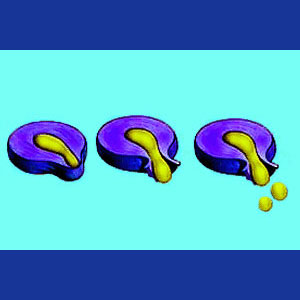
A sequestered disc fragment is defined as a piece of the internal intervertebral center, called the nucleus pulposus, which separates off the main disc structure and potentially migrates throughout the localized spinal anatomy. A sequestered disc describes a herniation which leads to a rupture and subsequent expulsion of some, or all, of the nucleus. A disc fragment describes one of these expelled pieces. Cervical herniated discs are extremely commonplace and may take many forms, including bulges, prolapses, extrusions and sequestrations. None of these forms are inherently more problematic than any other.
This essay concentrates on explaining the incidence of fragmented and free-moving disc pieces. We will explore how fragments can cause neck symptoms in some patients, as well as investigate what causes intervertebral structures to fragment in the first place.
Causes of a Sequestered Disc Fragment
Disc fragments come from several possible scenarios detailed below:
Large annular tears, in otherwise intact discs, can allow large fragments of the nucleus pulposus to escape confines within the disc body. These holes in the annulus fibrosus can be caused by normal degenerative processes or may be produced spontaneously through traumatic neck injury.
Annular tears caused by degeneration are not likely to be painful or symptom-generating, but may be in rare circumstances. However, annular tears enacted by injury are likely to be painful and may even create acute neck pain.
Ruptured cervical discs also demonstrate annular tears, but also generally lose their structural integrity and often spill some, or all, of their nucleus material rather quickly. As above, ruptures can occur over time, due to wear and tear, or may be the result of sudden damage to the intervertebral disc.
Symptoms of a Disc Fragment
Just because a free moving disc fragment exists, does not mean that any symptoms will be produced. In fact, most fragments are completely asymptomatic. However, if a fragment affects a nerve tissue, then symptoms may result and might even become a serious health crisis. Here are some of the possible explanations for verified symptomatic expressions induced by fragmented discs:
A fragment might lodge in the central spinal canal, enacting or contributing to central spinal stenosis. This is often seen in combination with other canal narrowing criteria, such as arthritic changes or ligament hypertrophy.
A fragment may block the opening to the foraminal space, possibly pinching a cervical nerve in the process. Compressive neuropathy conditions in the neck will produce a definitive and predictable symptomatic pattern and should always be treated by an expert in spinal neurology for best results.
Disc fragments contain a chemical called Tumor necrosis factor-alpha. This organic chemical can cause irritation to the nerve roots through a process named chemical radiculitis.
Calcified fragments can worsen the arthritic interactions at affected spinal levels and may even contribute to mechanical neck pain in some patients.
Prognosis for a Sequestered Disc Fragment
A sequestration can range from a minor and inconsequential occurrence to a significant health threat, depending on its severity, location and effects. No 2 intervertebral concerns are exactly alike. Statistic clearly show that most sequestrations are non-issues, yet some can still become real problems when nerve or spinal cord compression results.
It is vital to understand that most disc fragments are both soft and non-pressured. They are not likely to compress any tissue at all, even upon direct contact. However, these fragments can contribute to the formation of osteochondral bars in some patients, offering a far better chance for neurological effects to occur. To learn more about intervertebral fragmentation, talk to your orthopedist or spinal neurologist.
Neck Pain > Herniated Disc Neck Pain > Sequestered Disc Fragment





